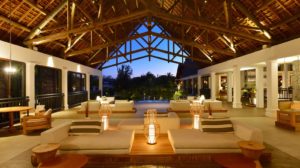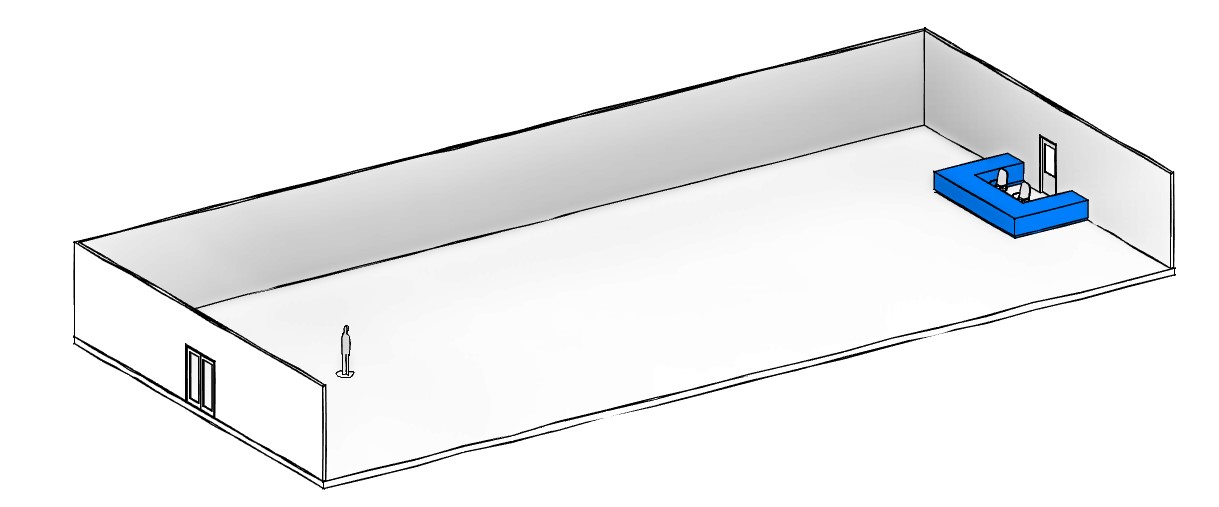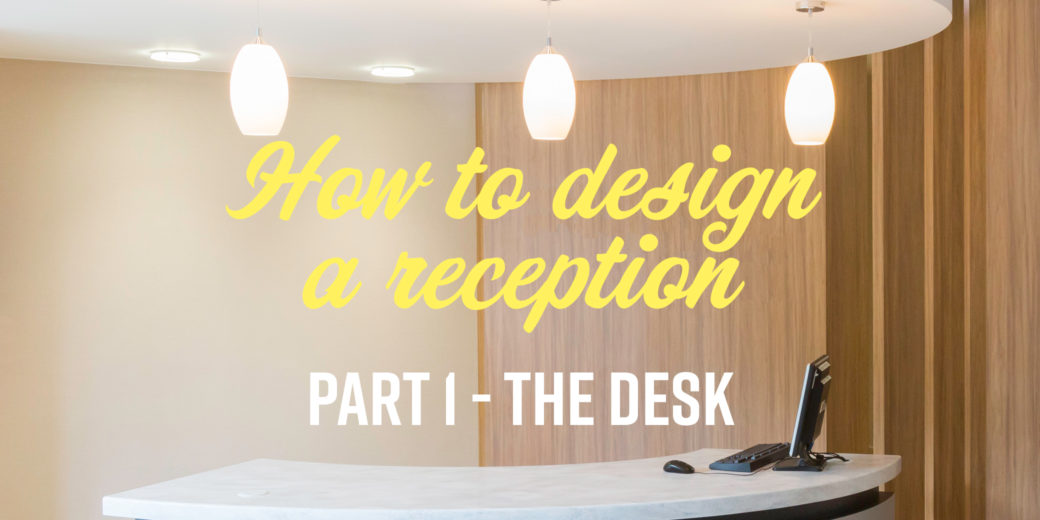For many organisations, reception is where that first impression is made. A good reception will reinforce your brand – in terms of style and service – and will set expectations for what’s to come. It can also influence your mood: imagine how you would feel after arriving at reception for a meeting and not being sure where to go, not being able to catch the eye of the receptionist* and of being kept waiting with no-where to sit and nothing to look at but a blank wall. That mood will carry through to your meeting and, however courteous your host is, will take a while to shift.
I asked my colleagues to look at three groups of images and write down their first impressions (in keywords) and what sort of organisations they associated with them. We then discussed our responses and all had broadly the same ideas. Take a look at the groups and see what you think (our thoughts at the end).
[*This blog focuses on the design of reception but people are also very important, obviously]
The Desk

The Ravenala Attitude Copyright: virginie tenant lacoste
When I arrived at this hotel (on honeymoon, we’re not usually that fancy) we didn’t go to a desk – we were greeted and shown to a sofa, given a drink and handed a tablet to check-in on. After a long journey it was nice to get such personal, comfortable service. This approach is also being taken in banks and hospitals, where greeters intercept you at the entrance, take your details and direct you to the correct area.
So, is a reception desk even needed? Well…generally, yes. A desk acts as a big signpost for help, they are familiar and we know what we’re expected to do (we can queue, rather than anxiously huddle). At a minimum, some form of desk is generally required as a base for the receptionist / greeter and to house IT equipment, although tablets have made much smaller kiosks viable.
Desk Considerations
Presuming a reception desk is required, there are several things to think about when pulling together the design:
Location
One of the first things we’ll consider when designing a reception area is where the best location is for the desk. Sometimes this is defined by the position of a back office or other key adjacency, but it can be fairly self-contained. Often, we will position the desk in front of a side wall – providing a good view of the whole space and allowing use of the wall for signage.
Be cautious about positioning the desk directly opposite the entrance; it can appear too dominant, even aggressive, and may make it more difficult to manage flows through the space. A central desk, unless manned by several members of staff, can mean that staff sometimes have their backs (and screens) to visitors – which is unwelcoming and a potential security issue. It also creates a much larger area which must be kept free for visitors to approach, is more difficult to provide with power and has no rear wall for signage.
Another consideration is the distance away from the door; the desk should be obvious from the entrance and there should be a comfortable distance from the door – not so close that a queue obstructs access, not so far that the visitor feels awkward on a lengthy approach. Staff at reception should then be able to easily direct the visitor to the seating area and keep an eye on them while they’re waiting.

Awkward smiles all the while
Size
We generally size a desk to suit the number of staff it needs to cater for, but size can be played with to create a statement or define the space. It’s also worth remembering that the organisation’s needs might change – will it be possible to accommodate more staff in future?
Use – staff
We also need to think about how the desk is staffed – will there always be someone there? If not, the desk should be able to be secured with a place for everything to be locked away.
If reception is the staff’s only base, they will need storage for personal belongings and easy access to refreshments and WCs – particularly if there is only one person staffing the desk. Often a reception desk leads to a back office, which can reduce clutter – particularly if large items like multi-function printers are required.
The use of PCs can also have a big impact on the design of the desk. The use of laptops and tablets has increased over the years, particularly where desks are not continuously staffed, but for most organisations a PC with monitor is still required. Upstands / writing shelves and careful planning of cable management can reduce trailing wires, but it’s often a difficult balance between practicality and tidiness.
It’s also worth considering the range of switches and alarm panels required as early as possible in the design of the desk area, so that they can be incorporated into the design. Alarm panels are not often beautiful, but could be lifesaving – so we need to make sure their position is practical, whilst minimising their visual impact to visitors.
Use – visitors
What will visitors to the building be doing? If they need to sign in (or have something signed for) then a high section of counter will make it easier for people standing. If deliveries are being made, make sure the counter material can handle heavy items being pushed across the top and think about where they can be stored out-of-sight until they reach their final recipient.
The types of people that are most likely to visit will also have a bearing on the desk design, which I’ll cover further in the ‘accessibility’ and ‘security’ below.
Accessibility
We always aim to create inclusive environments, as should clients representing their company’s core values.
Think about the possible users of the desk and how to make their arrival safe and welcoming. It is standard practice to have a section of counter that allows wheelchair access (low counter with knee recess) but we also need to consider visitors with other needs, for example, people with: other mobility impairments; hearing impairment; visual impairment; learning difficulties or dementia.
Put yourselves in their shoes and think about their approach to the desk. How easy might it be for a visitor to lip read or use sign language? Could glare be a problem? Should assistive listening systems (e.g. induction loop) be installed? Is signage clear?
It’s also important to note that it’s not just visitors that need consideration, staff may have additional needs too. It should be possible for a member of staff using a wheelchair to greet a visitor using a wheelchair.
The desk should obviously also meet Building Regulations. Further guidance can also be found in British Standard BS8300.
Security
Security is an increasingly important aspect of reception design. As I’ve already said, the desk should provide a good view of the entrance and waiting areas for general surveillance; consider the need to fit a panic button under the desk too.
It’s important to assess the security risk and provide a considered approach based on the likely aggression of visitors. The most obvious protection is the sort of glass screen you get at the Post Office, but these can disrupt communication and are unwelcoming. Higher counters can also provide guarding, but limit accessibility and views out. An extra deep counter is a better solution – this limits the visitors reach and has the extra benefit of making it easier to accommodate wheelchair access.
The shape of the desk can also help; a desk with closed sides should discourage visitors from coming around to the back of the desk, whether staffed or not. A gate or flap can be provided if staff need to access the desk via the main space, or even just provide the ability to come out from behind the desk to assist visitors, whilst a completely closed desk with access via a rear door will also provide a secure escape route.

Comfort
Don’t forget about the comfort of people working on reception as well as visitors – a cold receptionist will find it harder to give a warm welcome! Plinth heaters, particularly where receptionists have control, can be useful.
It is also important not to abandon ergonomics for aesthetics – the staff on reception may work long hours and will need a comfortable task chair and appropriately-designed workstation.
Cost
Clients often start by thinking they can get something ‘off the shelf’, but as soon as we talk about their requirements, or even just analyse the space available, it becomes clear we’ll need something custom-made. As large, complicated pieces of furniture, bespoke reception desks can be costly – which it makes it even more important to get it right.
Style
I’ve already talked about how the style chosen for reception can express brand identity and the desk plays a large part in that. Of course, in speculative developments or large office blocks receptions may have to cater for unknown, or several different, organisations. In these cases, it is often safer to use neutral colours (to avoid branding clashes) but in finishes that create a high-quality feel.
Check out some inspiration here.
Maintenance
Reception desks are generally designed to attract attention, but you don’t want it to be for the wrong reasons! Being under such scrutiny, it’s important that the desk continues to look good; be careful about choosing cheaper, but less durable, finishes – it may end up costing more in the long run. Which moves us neatly on to…
Materials
A reception desk can be made of, or finished with, almost anything. Here are a few of the materials we’ve used in the past:
- Solid surface – can be formed seamlessly into almost any shape, comes in a wide range of colours and can be back lit. Will scratch (more noticeably on dark colours) but can be refinished. Tends to be fairly expensive.
- Laminate – very commonly used, huge colour range and hardwearing (providing there’s protection to the edge) however if it is scratched or chipped it will need to be replaced. Panel joints need to be built into the design.
- Timber and veneer – a classic look with a wide range of veneers and finishes available. Likely to wear and, depending on finish, change colour over time but can be refinished if necessary.
- Concrete – can be cast into almost any shape. The surface can be polished smooth or left rough and raw but will need to be sealed to avoid staining.
- Linoleum – Not one for the whole desk, but this is great as a writing surface as it gives under pressure.
- Glass – great for fronts and screening monitors, can be clear / translucent / opaque / frosted / back-lit and printed on but, like laminate, panel joints need to be built in (and may be smaller than laminate due to the weight of glass).
- Metal / stainless steel – can be left with a natural finish and welded or riveted joints or smoothed and coated. Very malleable, so can be formed to various shapes, although cold surface may limit use as counter. Regularly combined with other materials as a plinth.
- Tile – Search for ranges that have special edging and corner tiles for a more sculptural look. Tiles are not the best material for a workstation (cold and poor writings surface), but are well suited to front panels.
- Lighting – not strictly a material, but lighting incorporated into a desk can bring out the best in the finishes used and add a bit of extra wow-factor.
Delivery
Finally, how will the desk be installed – built on-site or delivered? If the desk is going to be delivered, make sure there is a clear access – desks can be very large and may need to be made in pieces that can be more easily transported and / or accommodated in lifts. Some materials can be joined seamlessly on-site by specialist contractors but with most it is best to think about how the joints can be incorporated in the design.
So, the desk is sorted – what else?! Read Part II (Coming Soon!) to find out more about what we consider when designing the rest of the reception area.






